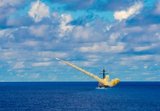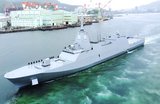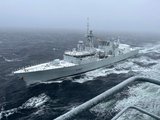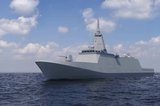USN orders post-delivery work on USS Vermont
USS Vermont, pictured in October 2020 (Photo: USN/Petty Officer 3rd Class Christian Bianchi)
General Dynamics Electric Boat has received a $13.09 million contract modification from the USN for ‘planning and execution of USS Vermont (SSN 792) post-delivery work period’, the DoD announced on 4 November.
Work on the first Block IV Virginia-class fast attack submarine will be performed in Groton, Connecticut, and is expected to be completed by May 2022.
Construction of USS Vermont began in May 2014 and it was commissioned into the USN in April 2020 as the 19th Virginia-class boat. These submarines perform a range of key functions including anti-submarine and anti-surface warfare, ISR, mine warfare and SOF transportation.
Related Equipment in Defence Insight
More from Naval Warfare
-
![Future Canadian Continental Defence Corvette will provide “Halifax-equivalent capabilities”]()
Future Canadian Continental Defence Corvette will provide “Halifax-equivalent capabilities”
Although the CDC project is still in its early stages, the Canadian Department of National Defence already has some requirements for the future platforms.
-
![US Navy to acquire micro-uncrewed underwater vehicles for ISR and coastal data collection]()
US Navy to acquire micro-uncrewed underwater vehicles for ISR and coastal data collection
The Naval Supply Systems Command is seeking authorised resellers of JaiaBot uncrewed underwater vehicles and multivehicle pods. The platforms will support undergraduate education at the US Naval Academy.
-
![NATO tests use of “undetectable, jam-proof” laser communication in maritime scenarios]()
NATO tests use of “undetectable, jam-proof” laser communication in maritime scenarios
As part of its effort to better prepare its capabilities for operations in contested and congested scenarios, NATO evaluated a Lithuanian ship-to-ship terminal designed to not be susceptible to enemy interference.
-
![Future of the Canadian Patrol Submarine Project is still unclear]()
Future of the Canadian Patrol Submarine Project is still unclear
The Canadian government remains tight-lipped on the timeline and funding required for the next steps of its Canadian Submarine Patrol Project, which should offer improved capabilities for the country’s navy.
-
![Mitsubishi eyes future with Australia’s Mogami selection]()
Mitsubishi eyes future with Australia’s Mogami selection
With Australia’s selection of the Mogami-class for Project Sea 3000, Mitsubishi is investigating local production in the next decade as potential export opportunities emerge.
























